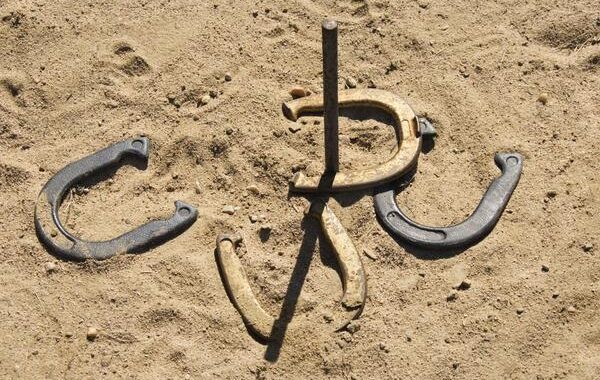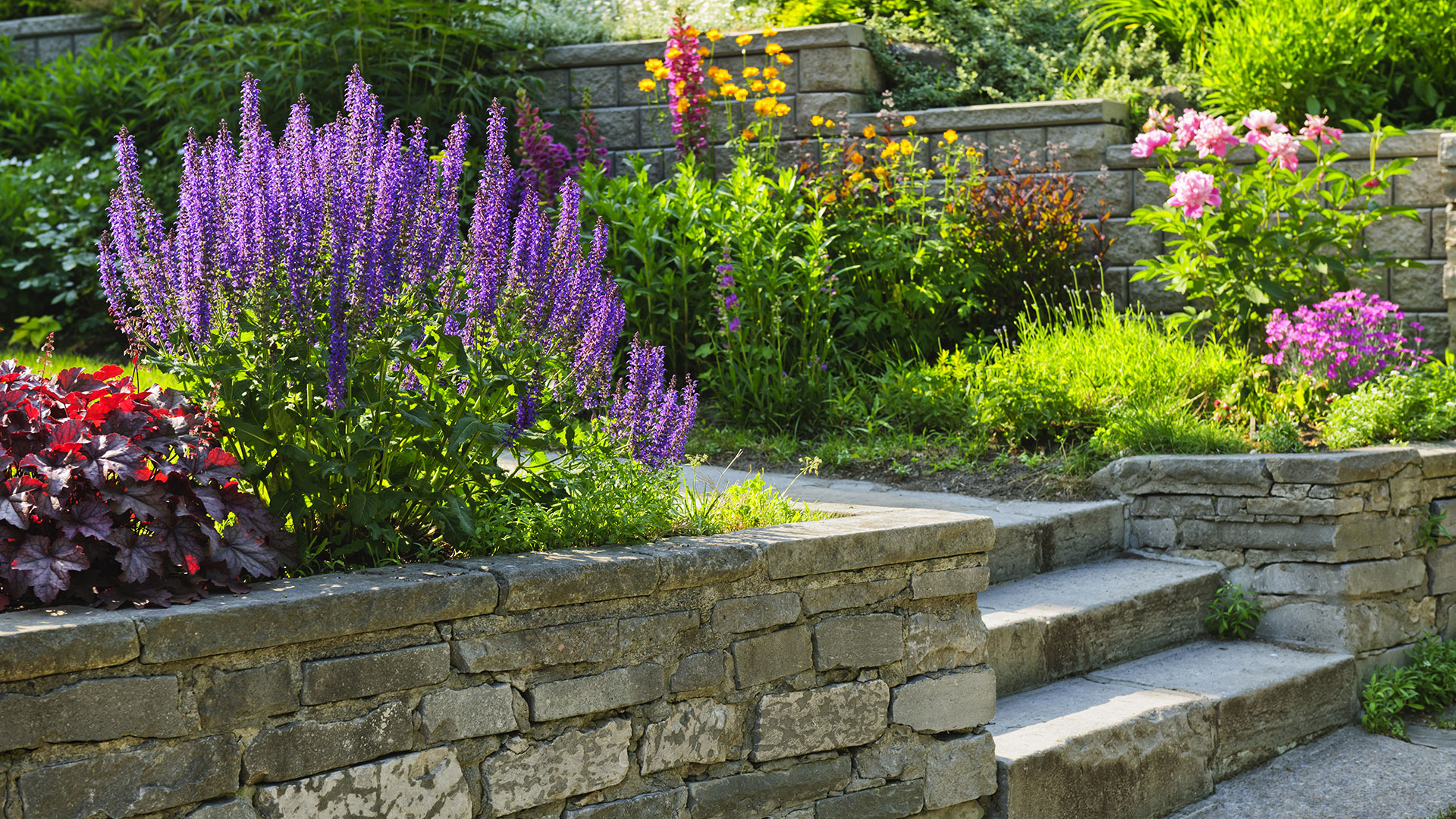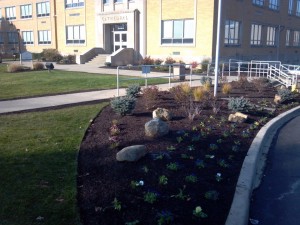
Project Cut List and Plans
four 2×10 x 48″ for the backboard
four 2×4 x 22″ for the backboard
eight 2×4 x 72″ for the pitching platforms
twenty 2×4 x 15″ for the pitching platforms
two 4×4 x 84” posts
twelve 5/4″ x6 x 72″ deck boards
All the materials can be found at any large home-improvement store, (except for the horseshoes). Have the store cut the 12’ deck boards in half so it will be easier to transport them.
Much of this project can be built indoors then taken to the site for installation. We made the center/sand area of our pit four feet wide. Regulation states it should be three-feet wide. You can adjust accordingly.
A Few Tips Before You Get Started
- When using any saw, let blade get up to full speed and then slowly push through the wood using even pressure. Always use a sharp blade for safety and it is will cut easier. A dull blade will force you to push harder which may cause the saw or material to jump.
- When using a circular saw, make a mark across the entire length of the piece so you can follow it with the blade. This will help keep the cut from binding.
- When shopping for lumber, look down the length of the material and try to find straight pieces or at least the straightest.
- If there is a bow in the material, put the bow against the miter saw’s fence at the cutting blade so that it bows away from the saw at the ends. If the piece is tight on the ends and bowed away at cutting blade, the saw may pull it back at the end of the cut and slam the piece against the fence.
- Most lumber does not come with square ends, it is usually is longer than the specified lengths, i.e. — an 8-foot length 2×4 is usually 8’-3/4” long. This allows you to square up the ends before final cuts to length, but be sure to measure first before squaring it up. Watch for staples in ends where tags have been attached, they can catch in the saw blades and be tossed out (one of the many reasons to always wear safety goggles).
- When using a miter saw or circular saw, make sure to have proper support of the material. Miter saws should have a stand or table to catch pieces. Circular saws should have two supports each on both sides of the piece being cut, so there is not a piece dropping after the cut.
- When inserting 3-inch screws into 2x4s, angle the screws slightly so they do not protrude through the other side.
Measure for the Pitching Platform
The two side platforms are where a player stands to toss the horseshoes to the other pit. They stand at the back of the platform, take two steps forward and pitch each horseshoe.
Cut eight of the 2×4 to 72 inches. Save the cut off pieces. Cut the eight saved pieces and two of your 2x4s into twenty 15-inch pieces.
Lay one of the 72-inch pieces on its side. Perpendicularly place five of the 15-inch pieces, evenly spaced across the 72-inch board. Here is the easiest way to determine equal spacing:
Add the amount of pieces by their width: 5 plus 1-1/2″ = 7-1/2″.
Then minus that from total length: 72″ – 7-1/2″ = 64-1/2″.
Then divide by the number of spaces: 64-1/2″ divided by 4 = 16-1/8″.
Thus, there is 16-1/8″ between each 2×4.
Mark the 1-1/2″ thick 2x4s on the small side of each end of the 72-inch board and measure over 16-1/8″ and mark another 1-1/2″ and continue. Put a mark across the edge on both sides of the 2×4 with an “X” in the center so there’s no confusion as to where you will fasten the boards.
Lay the other 2×4 x 72″ boards against the one you just marked. Transfer all the marks across to the other boards using a carpenter’s square.
Build the Pitching Platform Frame
Pre-drill two holes in each of the 1-1/2″ marks through the tall side. Lay two of the 72-inch boards with five of the 15-inch pieces on the marks and test fit. Screw the pieces together using 3-inch screws. It makes is easier if the back is resting against something or you have a helper holding it.
Repeat for the three remaining pitching platforms.
Cut the 5/4″ x 6 boards to 72 inches. If you had them precut at the store, you may want to check length and square them up. Lay the boards on top of the frame and test fit. Do not fasten the deck boards to the frame at this time. It is best to do that at the site during installation.
Build the Backboard
- Cut the two 2×10 x 8′ into four 48″ lengths.
- Cut two of the 2×4 x 8′ into eight 22″ lengths.
Cut the two 4x4s to 84″.
The 4×4 post will run the length of the two platforms and the backboard. To hold up the backboard, two notches must be cut into the 4×4. To determine the placement of the notches, find the center of the 4×4 and make a mark. Make two more marks at two feet out from that mark in both directions.
To mark out the width of the notches on the 4×4, lay a scrap piece of 2×4 on the inside of those marks (image 1, below). Make a line on both sides of the 2×4. Double check that the spacing is even across the length of the 4×4.
Make the Stakes
We used couple of really inexpensive ($1 each) plastic planters for stake supports. Fill the planters half full with the concrete, add water and mix thoroughly. Add more concrete and water until the bucket or planter is full. Set a stake (we used rebar) into the center and support them. We simply leaned the stakes against the top of a table. Let the concrete dry according to manufacturer’s instructions.
Assemble the Platforms to Backboard
Move all the pieces the installation spot.
Lay one of 4x4s with the backboard standing up on ground. Measure 48 feet and place the other 4×4 and backboard.
Set the pitching platforms against the 4x4s, then screw then together using 3″ screws.
Lay the deck boards onto the platform frames. Line up two on the outsides and then center the last, there will be gaps between them. Use 1-5/8″ screws to fasten the deck boards to the frame.
Set the Structures in the Ground
Double check the 48-foot measurement, this is inside to inside of the backboard.
Take a long string and run it against the side of a pitching platform all the way to the opposite pitching platform. The sides should line up square.
When the platform is in place, spray paint completely around the edges for a reference. Move the structures to the side then remove the sod from the area; add more soil if needed to make the area level. Add some extra soil where sand pit will be. Put the structure back into place and check for levelness.
The stake needs to be 48 inches in front of the backboard, and centered in between both pitching platforms, stand 15 inches tall and tilt slightly forward. Dig hole to set bucket, go as deep as you need to get to 15-inch height. If you have extra concrete, pour it dry around the bucket before backfilling with dirt.
We placed a cap on the top of stake for safety reasons. Fill the pit with play sand and start playing.


